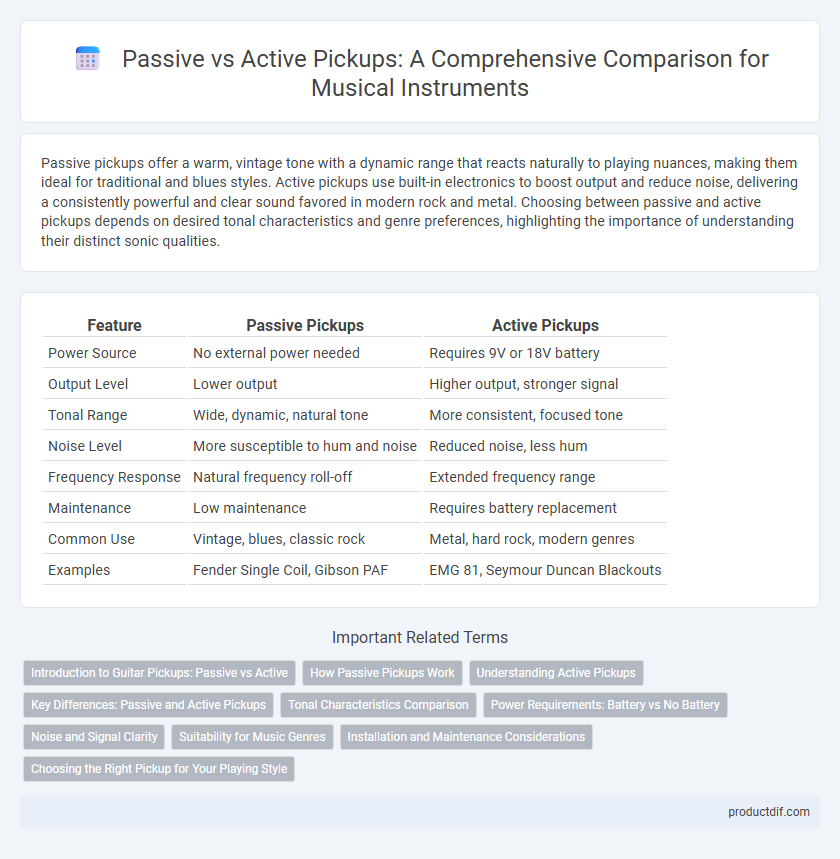Passive pickups offer a warm, vintage tone with a dynamic range that reacts naturally to playing nuances, making them ideal for traditional and blues styles. Active pickups use built-in electronics to boost output and reduce noise, delivering a consistently powerful and clear sound favored in modern rock and metal. Choosing between passive and active pickups depends on desired tonal characteristics and genre preferences, highlighting the importance of understanding their distinct sonic qualities.
Table of Comparison
| Feature | Passive Pickups | Active Pickups |
|---|---|---|
| Power Source | No external power needed | Requires 9V or 18V battery |
| Output Level | Lower output | Higher output, stronger signal |
| Tonal Range | Wide, dynamic, natural tone | More consistent, focused tone |
| Noise Level | More susceptible to hum and noise | Reduced noise, less hum |
| Frequency Response | Natural frequency roll-off | Extended frequency range |
| Maintenance | Low maintenance | Requires battery replacement |
| Common Use | Vintage, blues, classic rock | Metal, hard rock, modern genres |
| Examples | Fender Single Coil, Gibson PAF | EMG 81, Seymour Duncan Blackouts |
Introduction to Guitar Pickups: Passive vs Active
Guitar pickups convert string vibrations into electrical signals, with passive pickups using magnets and coils to produce a warm, dynamic tone favored in blues and rock. Active pickups, equipped with built-in preamps powered by batteries, deliver higher output and reduced noise, ideal for heavy metal and modern genres. Choosing between passive and active pickups depends on the desired sound clarity, output level, and playing style preferences.
How Passive Pickups Work
Passive pickups function by capturing the vibrations of the guitar strings through a coil of wire wrapped around a magnet, creating an electromagnetic field that converts string motion into an electrical signal. These pickups do not require an external power source, relying solely on the magnetic field and coil design to generate a warm, natural tone with dynamic responsiveness. The simplicity of passive pickups allows for a wide dynamic range and a tonal character favored in genres like blues, rock, and jazz.
Understanding Active Pickups
Active pickups use an internal preamp powered by a battery to boost the signal strength, providing higher output and clearer sound with reduced noise compared to passive pickups. They offer enhanced tonal versatility and are favored in genres requiring precise sound clarity and sustain, such as metal and hard rock. Unlike passive pickups, active pickups have a consistent frequency response regardless of cable length, maintaining signal integrity over long signal chains.
Key Differences: Passive and Active Pickups
Passive pickups rely on magnetic induction and coil wire to generate natural, warm tones with dynamic responsiveness, making them versatile for various musical styles. Active pickups include a built-in preamp powered by a battery, delivering higher output, reduced noise, and more consistent sound with enhanced clarity and sustain. The key difference lies in passive pickups' organic tonal variation versus active pickups' boosted signal strength and noise reduction capabilities.
Tonal Characteristics Comparison
Passive pickups deliver a warm, dynamic tone with rich harmonics and natural gain responsiveness, favored for classic rock and blues genres. Active pickups produce a cleaner, more consistent output with enhanced clarity and higher gain headroom, ideal for heavy metal and modern styles. The choice between passive and active pickups significantly affects the instrument's tonal versatility and overall sound character.
Power Requirements: Battery vs No Battery
Passive pickups operate without an external power source, relying solely on the electromagnetic field generated by the strings' vibrations, which results in no battery requirement and a natural, dynamic sound. Active pickups incorporate a built-in preamp powered by a 9-volt battery, enhancing output signal strength and noise reduction, but necessitating regular battery replacement to maintain performance. The choice between passive and active pickups significantly impacts the instrument's tonal characteristics and maintenance needs related to power management.
Noise and Signal Clarity
Passive pickups typically generate a warmer tone with more natural dynamics but are more susceptible to electromagnetic interference, resulting in higher noise levels. Active pickups use an onboard preamp powered by a battery, which boosts the signal strength and enhances signal clarity by reducing noise and hum. Musicians seeking cleaner output and consistent performance often prefer active pickups for environments with high electrical interference.
Suitability for Music Genres
Passive pickups excel in delivering warm, vintage tones ideal for blues, rock, and jazz, offering dynamic response and natural harmonics favored by traditional players. Active pickups provide higher output and reduced noise, making them suitable for metal, hard rock, and genres requiring aggressive sound with precise articulation. Guitarists often choose passive pickups for classic genres and active pickups for modern, high-gain styles.
Installation and Maintenance Considerations
Passive pickups require minimal installation effort, typically involving straightforward soldering to standard wiring configurations and do not need a battery compartment, reducing ongoing maintenance. Active pickups demand more complex installation, including installing a 9V battery or power source, careful wiring to accommodate preamps, and extra cavity routing if the instrument lacks space. Maintenance for active pickups involves periodic battery replacement and potential troubleshooting of electronic components, whereas passive pickups generally offer greater reliability with less frequent upkeep.
Choosing the Right Pickup for Your Playing Style
Passive pickups deliver a warm, vintage tone favored by blues and classic rock players, with a dynamic range that responds naturally to picking intensity. Active pickups offer higher output and reduced noise, ideal for metal and modern genres requiring heavy distortion and clarity. Selecting the right pickup depends on your musical style, desired tone, and performance environment to achieve optimal sound quality.
Passive pickups vs Active pickups Infographic

 productdif.com
productdif.com